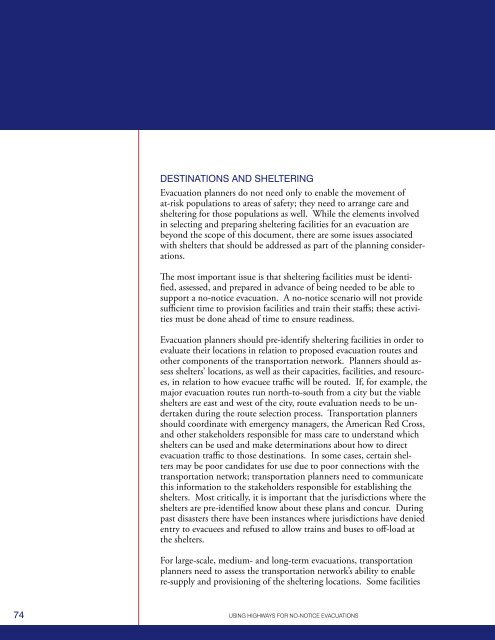using highways for no-notice evacuations - FHWA Operations - U.S. ...
using highways for no-notice evacuations - FHWA Operations - U.S. ...
using highways for no-notice evacuations - FHWA Operations - U.S. ...
Create successful ePaper yourself
Turn your PDF publications into a flip-book with our unique Google optimized e-Paper software.
DESTINATIONS AND SHELTERINGEvacuation planners do <strong>no</strong>t need only to enable the movement ofat-risk populations to areas of safety; they need to arrange care andsheltering <strong>for</strong> those populations as well. While the elements involvedin selecting and preparing sheltering facilities <strong>for</strong> an evacuation arebeyond the scope of this document, there are some issues associatedwith shelters that should be addressed as part of the planning considerations.The most important issue is that sheltering facilities must be identified,assessed, and prepared in advance of being needed to be able tosupport a <strong>no</strong>-<strong>no</strong>tice evacuation. A <strong>no</strong>-<strong>no</strong>tice scenario will <strong>no</strong>t providesufficient time to provision facilities and train their staffs; these activitiesmust be done ahead of time to ensure readiness.Evacuation planners should pre-identify sheltering facilities in order toevaluate their locations in relation to proposed evacuation routes andother components of the transportation network. Planners should assessshelters’ locations, as well as their capacities, facilities, and resources,in relation to how evacuee traffic will be routed. If, <strong>for</strong> example, themajor evacuation routes run <strong>no</strong>rth-to-south from a city but the viableshelters are east and west of the city, route evaluation needs to be undertakenduring the route selection process. Transportation plannersshould coordinate with emergency managers, the American Red Cross,and other stakeholders responsible <strong>for</strong> mass care to understand whichshelters can be used and make determinations about how to directevacuation traffic to those destinations. In some cases, certain sheltersmay be poor candidates <strong>for</strong> use due to poor connections with thetransportation network; transportation planners need to communicatethis in<strong>for</strong>mation to the stakeholders responsible <strong>for</strong> establishing theshelters. Most critically, it is important that the jurisdictions where theshelters are pre-identified k<strong>no</strong>w about these plans and concur. Duringpast disasters there have been instances where jurisdictions have deniedentry to evacuees and refused to allow trains and buses to off-load atthe shelters.For large-scale, medium- and long-term <strong>evacuations</strong>, transportationplanners need to assess the transportation network’s ability to enablere-supply and provisioning of the sheltering locations. Some facilities74USING HIGHWAYS FOR NO-NOTICE EVACUATIONS
















